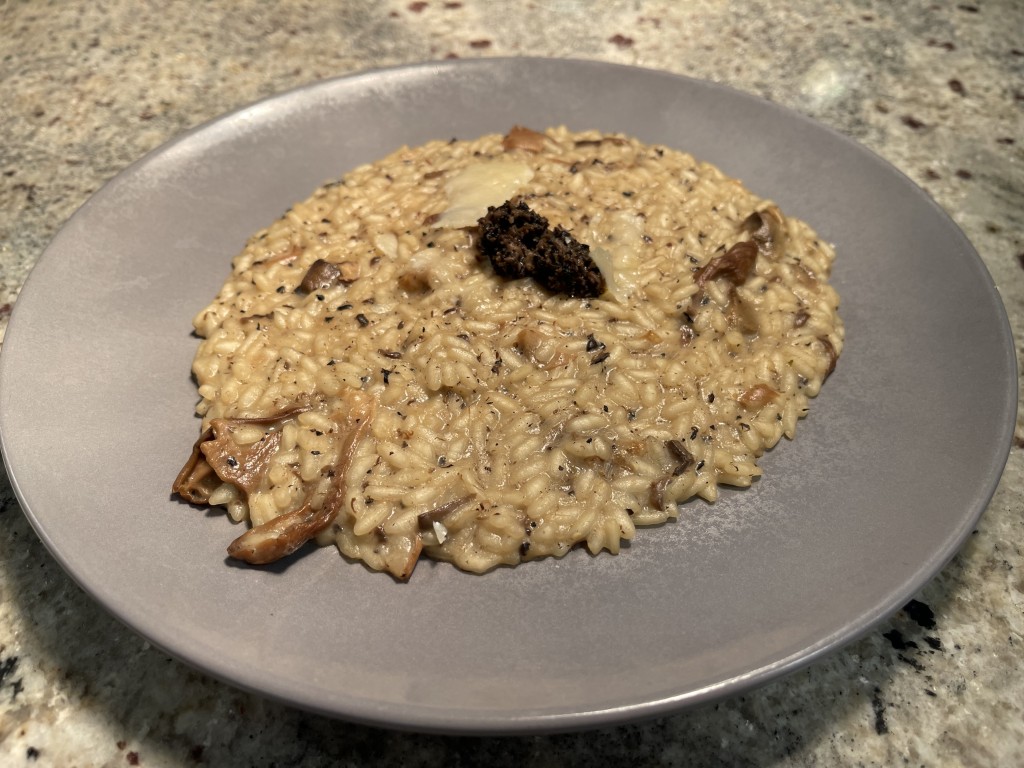Risotto is a classic Italian dish that has a rich and fascinating history. This creamy rice dish has deep roots in Italian culinary traditions and has evolved over centuries to become a beloved staple in Italian cuisine. The history of risotto is not just a tale of a delicious dish, it’s also a testament to the creativity and resourcefulness of Italian cooks.
Food & Beverage Magazine features “Risotto with Chef Attilio Borra.
The origins of risotto can be traced back to the north of Italy, specifically the regions of Lombardy and Piedmont. The earliest precursor to risotto was a simple rice porridge that dates as far back as the 11th century. Rice, which is not native to Italy, was introduced to the region through trade with Asia, the Middle East, and North Africa. Initially, rice was considered a luxury item and was primarily used in desserts and other sweet dishes.
It was in the 14th century that rice began to be cultivated more widely in the Po Valley of northern Italy, and it gradually found its way into savory dishes. The wetlands and rice paddies in the region provided the ideal conditions for rice cultivation, and this led to the development of new rice-based dishes, including what we now know as risotto.
Risotto as we recognize it today started to take shape in the 18th century. The essential ingredients, rice, broth, and cheese, came together in a recipe that highlighted the creaminess and rich flavor that is characteristic of risotto.
In the province of Vercelli, Piedmont region, there is a town called Arborio, and in the early 1940’s Dr. Domenico Marchetti an agronomist born right there, wanted to dedicate a variety he selected. It’s an intersection of two varieties of the time, the Vialone (not to be confused with the Vialone Nano today), and the Lady Wright, an american forgotten variety, and then introduced fully in rice production in 1967. Arborio rice is known for its high starch content, which gives risotto its characteristic creaminess. Today this variety of rice is also grown in the U.S. in states such as California and Texas. Arborio rice is short, fat, and slightly oval-shaped with a pearly white exterior. There are various size designations, of which super fino, the largest grain size, is the one most commonly used in the United States. Arborio rice is high in amylopectin, a starch present in rice. Because it undergoes less milling than ordinary long-grain rice, arborio retains more of its natural starch content. Cooking the rice releases this starch, resulting in a firmer, chewier, and creamier rice compared to other kinds of rice. Although Arborio is among the most common rice known all over the world to cook a risotto, in Italy the variety most used for this dish is called Carnaroli. Carnaroli rice was born in 1945, thanks to the crossing of two varieties already present: Lencino and Vialone Nano. It was grown in the rice fields near Paullo, in the province of Milan, owned by Ettore de Vecchi. According to sources, rice was named after a commissioner of the National Rice Authority, Dr. Emiliano Carnaroli. This product was marked on the Varietal Register (which is responsible for classifying all the products of Italian agriculture, including rice) only in 1974. It was registered again in 1983 and its conservation passed from Achille de Vecchi di Paullo to the Ente Nazionale Risi, thus finally becoming a stable product. It is currently under strict control, just like all other Italian excellences. It is grown mainly in the area of the delta on the river Po, in Piedmont region and in the Lomellina area in Lombardy. It is important to buy it in regulated places, such as supermarkets, or else you will need to pay high attention. In fact, there are some similar rices, such as Carnise and Keope, which are sometimes sold as Carnaroli rice. The Carnaroli package must have the word CLASSICO on it to certify that it’s a 100% Carnaroli rice.
The differences between Carnaroli and the Arborio rice are:
Absorption of Liquid: Arborio rice tends to absorb liquid more quickly during the cooking process, which can lead to a slightly softer texture in the final dish. Carnaroli rice, with its higher amylose content, absorbs liquid at a slower rate.
Cooking Time: Arborio rice typically cooks a bit faster than Carnaroli. It usually takes around 12-14 minutes to reach the desired consistency when preparing risotto. Carnaroli rice requires a slightly longer cooking time, often around 15-20 minutes, to achieve the perfect texture. This extra time allows for more control over the cooking process.
Versatility: Arborio rice is more readily available and widely used in many risotto recipes. It is a good choice for dishes where a creamier texture is desired. Carnaroli rice is preferred by professional chefs and connoisseurs who appreciate its ability to maintain a firmer, separate grain structure. It is an excellent choice for more complex risotto recipes and dishes that require a distinct creamer yet an al dente texture.
Number of servings: Arborio rice is more commonly used domestically because the amount of servings usually don’t exceed 10 people. This allows the rice grain to be still creamy and compact when served. Carnaroli rice holds its texture better even if it’s cooked for a large number of portions since it holds its texture and it releases the same amount of starch for a creamy result.
In Italy rice is certified and protected by several consortium and nowadays there are many schools that teach more about it and there are even courses to become a Rice Sommelier that teach all of its features and senses when still raw. I’m honored to introduce to you a true Rice Sommelier that will share some interesting facts about it.
Let’s meet Valentina Masotti.
Valentina Masotti is an author and a certified rice sommelier. She holds lessons for Acquaverderiso, the first and only Italian company that applied sensory analysis to the rice.
She’s also a wine sommelier, she has published cookbooks on rice and offers online classes in Italian and English. Her website is www.ricesommelier.com
Let’s talk Risotto: Valentina, what is the typical rice to make a risotto?
The typical rice for risotto has a long grain. What does it mean? A long and oval grain, much larger than the slender asiatic rices. It has an opalescent spot inside and in Italy we call it “pearl”. The traditional italian rices for risotto are: Arborio, Carnaroli, Roma, Baldo, S. Andrea, Vialone Nano.
The Arborio and the Roma rice are among the most known rice to cook risotto in the U.S., why do you think that is?
Arborio has a large distribution because it is also cultivated in the U.S., but it’s mainly famous together with the Roma kind because of the Italian sounding. Arborio was widespread in Italy until the 90’s, but nowadays it has almost disappeared and replaced with similar rice like Carnaroli. The same destiny for Roma. When you buy Arborio and Roma in the USA you are probably buying just a fantasy name, but not the real Italian cultivar.
What should a consumer look for when he buys a package of rice?
The consumer should check warranty seals, like the international seal PDO and PGI. When you buy Arborio, Carnaroli and other rice with the PDO or PGI seal you are sure to buy the authentic Italian one. The same if you find the seal “Classico” near the rice name. You could also look for the cultivation country on the label: even if it’s not mandatory outside of Italy, some producers could voluntarily write it on the packaging.
How is the culture on rice changing in Italy and in the world?
In Italy younger generation people like more ethnic dishes like sushi and pork, that’s why in Italy the second most cultivated rice is a sushi type. But in the rest of the world italian risotto rice is still the most appreciated. As per the Rice producers, today are working to improve precision farming and instruments to move towards production sustainability. Organic farming are growing, even though are still a small niche, but farmers are applying strategies and especially a kind of culture that requires less or no water in the fields to preserve this important element.
What do you do to teach and spread more info about this wonderful product?
I work a lot with chefs and I post on the web and through the social media lots of contents and recipes. I’m proud to announce that in December I will be holding a FREE Webinar with the chef Attilio Borra about Italian rice and risotto making. We’ll be in an historical location, an authentic rice farm in a country of northern Italy, in which the participants can discover the secrets of rice and learn how to make a real Italian risotto. You may contact Chef Attilio for all the details about this webinar, we look forward to see many of you ready to cook with us.
Risotto is not just a dish; it’s a culinary masterpiece with a rich history that reflects the evolution of Italian cuisine. It has become a symbol of Italian gastronomy and is celebrated for its versatility, depth of flavor, and the meticulous preparation that goes into each plate. Whether enjoyed as a simple comfort food or a gourmet delight, risotto continues to be a timeless favorite for food lovers around the world.
The secret to cook an exceptional risotto lies in the technique, patience, and, of course, the quality of the ingredients used.
In this recipe, I will demystify the process and provide you with step-by-step instructions on how to create a delicious risotto that will impress your family and friends. Whether you’re aiming to prepare a classic mushroom risotto, a vibrant seafood version, or any other flavor combination your heart desires, this guide will equip you with the skills and knowledge to make a restaurant quality risotto in the comfort of your own kitchen. So, roll up your sleeves, gather your ingredients, and let’s embark on a culinary journey that will lead you to a bowl of savory, creamy, and utterly delicious risotto typical of this autumn season: Porcini Mushroom Risotto.
Read Also: F & B Magazine highlights The Goddess of Pop and Gelato
Ingredients for 4 people:
2 cups Carnaroli or Arborio rice (serving portion about 80grams per person)
2 oz dried porcini mushrooms – 1 and half oz fresh porcini mushrooms
5 cups vegetable broth (kept hot)
1 cup dry white wine
4 tablespoons of butter (must be kept in the freezer until right before it’s used)
1 cup grated Parmigiano cheese
4 teaspoons of truffle sauce or compote
Salt taste
Instructions:
Rehydrate the Dried Porcini Mushrooms by placing them in a bowl and cover them with warm water. Let them soak for about 30 minutes until they become soft. Once rehydrated, drain them and cut them not too finely. Save the mushroom soaking water for later. If you use fresh porcini mushrooms, clean them well and sauteed them few minutes in a pan with a drop of olive oil and a little parsley. Once they are cooked, set them aside.
Use a pot that should be about 12 inches wide and 8/10 inches tall, do not add oil, or any other condiment in it, heat it and add the rice. Start stirring well just so the rice doesn’t stick and burn. During this process it’s the only moment in which you can add the salt. To know when the rice is ready, look at the colour, it should be translucent at the edges, but if you are not a professional, a more easy way is to touch the grains with your hand, when it’s hot enough that it burns, it’s ready. At this moment deglaze with white wine and stir. Allow the wine to cook and evaporates all the alcohol, stir until it’s mostly absorbed by the rice. At this point, begin adding the hot vegetable broth one ladle at a time, stirring constantly. The broth level should barely cover the rice level. Wait for the liquid to be mostly absorbed before adding the next ladle. Halfway in to the rice
cooking, add the rehydrated mushrooms and the water used to soak them in, or the fresh sauteed mushrooms you set aside earlier. Keep stirring and add broth until the rice is creamy and cooked to the desired level of doneness. This typically takes about 15-18 minutes depending on the kind of rice you use. Once fully cooked, turn off the heat, and add the butter directly from the freezer. This thermal shock is necessary for the saturated fat of the butter to be absorbed by the starchy cream instead of just melting and add an oily layer on top of it, stir well until the butter is fully melted. Now add the grated Parmigiano, stir it as well until fully absorbed.
Plate the porcini mushroom risotto into your serving dish, give few hits on the bottom of the plate just so the rice spreads evenly in the dish, add a teaspoon of truffle sauce or compote on top, and enjoy your meal.
I hoped you liked this article, if you have more inquiries on this subject or want to know more on the Free Rice Webinar I will be holding in December, please write me on attilio.borra@fbmagazine.co. As always until next time: I see you in the kitchen. Ciao








